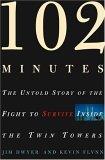
102 Minutes : The Untold Story of the Fight to Survive Inside the Twin Towers by Jim Dwyer & Kevin Flynn
It is shocking to look back and absorb that it only took 102 minutes. Almost 4 years later, we are still dealing with the fallout.
102 Minutes serves up a well-written, absorbing and highly detailed, moment-by-moment account of the 102 minutes from the impact of Flight 11 until the collapse of the second tower. Dwyer and Flynn, two reporters for the New York Times, have drawn on interviews, first-hand accounts, radio and 9-11 phone transcripts, cell phone and email messages, and official reports, to put together a staggeringly detailed and vividly realized account that weaves together lives, observations, stories and testimony into an absorbing and comprehensive whole.
102 Minutes is a very difficult book to pick up and even harder to put down. The book traces the events of the day, the paths of the survivors, the observations, structural forensic engineering studies, and the many heart-breaking communiques of the trapped. 102 Minutes is THE account to read.
Of particular note is the authors work at examining the base causes that often determined who lived and who died - both from the engineering side, examining the construction of the towers - and the short-sighted, preventable mistakes that ultimately contributed to high losses of rescue personnel in the disaster (of particular note - the lack of coordination between the various police and fire units, the inability of the older radio sets being used to enable communication with firefighters in the towers, the lack of communication between structural engineers who were observing the disaster and predicting a potential collapse - the list goes on...).
The book is strictly limited to the events at the WTC - not covering the attack on the Pentagon or the events on Flight 93 but in covering the WTC the way they have, the authors have put together an account that is hard, but brilliant.
102 Minutes is hard to top, both for the strength of its well-written prose, or for the careful detailed investigation that it reflects.
For more reading on 9/11 I also recommend Dennis Smith's superlative Report from Ground Zero: The Story of the Rescue Efforts at the World Trade Center.
Dennis Smith is a retired New York City firefighter turned author (Report from Engine Co. 92 is probably his most notable work). Smith has written a deeply personal and intensely moving account of the events of the day and the grim aftermath of three months working on The Pile, sifting the wreckage for the fallen and the lost. Smith's story is a chronicle of that loss, pulling out the first-hand accounts of firefighters, police and emergency workers and looking at the emotional aftermath and impact on the NYFD.
Also of note is, naturally enough, The 9/11 Commission Report...
For a good account of the engineering background on the collapse, check out this civil engineering site and for some background on the WTC, check out Great Buildings Online.
Visit the somewhat controversial plans for the WTC Memorial here, or view the site itself through EarthCams.
For still more info, drop by the September 11th Digital Archive. You might also want to have a look at Time Magazine's online photo essay, Shattered.
Thanks for reading!
